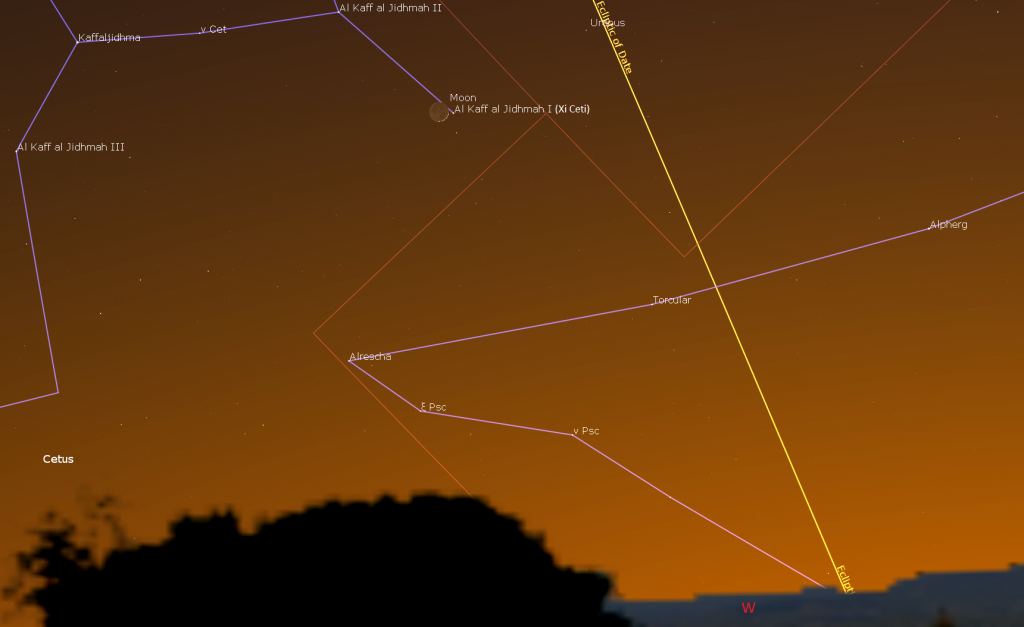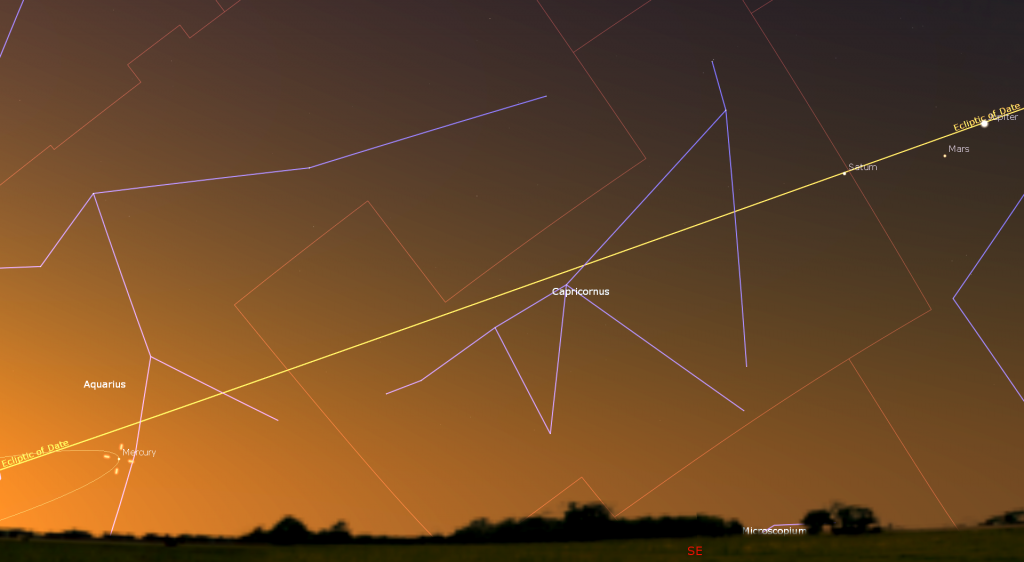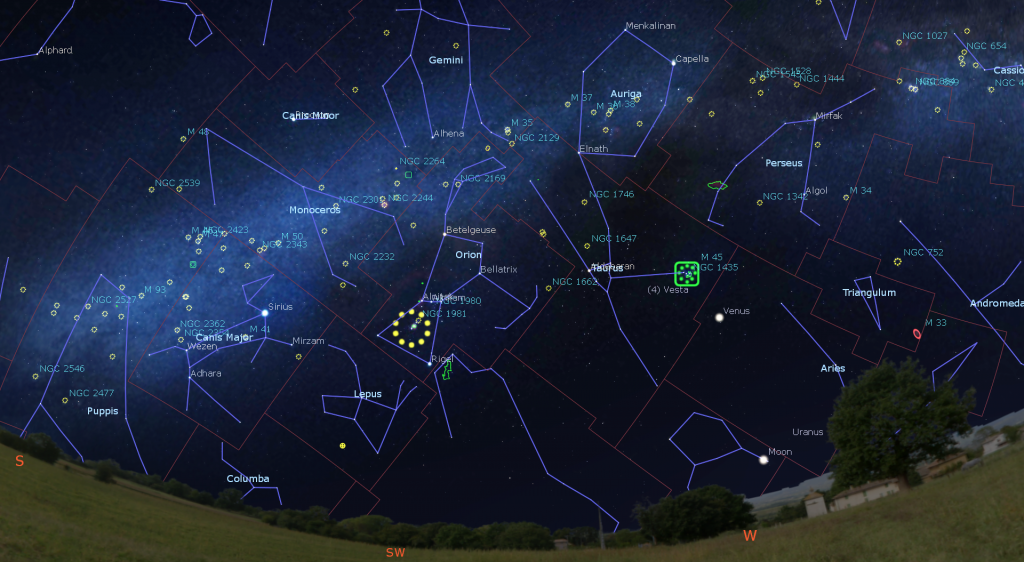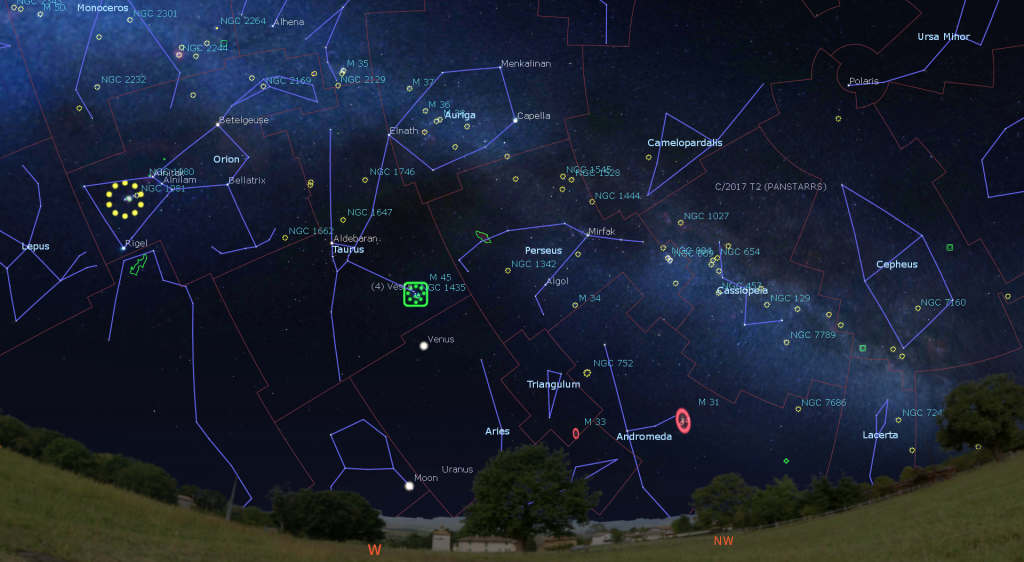Stargazing Suggestions, the Pretty Moon Poses with Evening Venus, and Morning Planet Antics!

This lovely widefield image of Auriga (the Charioteer) was taken by Alan Dyer of Calgary on January 23, 2011. It nicely shows the rich clusters and star fields that populate that constellation’s circlet of stars. The Flaming star Nebula is the red patch. Other knots of stars are open clusters. Capella, or Alpha Aurigae, is the bright yellow star at right. Alan’s photos can be viewed on his The Amazing Sky website here.
Hello, mid-March Stargazers!
Here are your Astronomy Skylights for the week of March 22nd, 2020 by Chris Vaughan. Feel free to send me your comments, questions, and suggested topics. You can also follow me on Twitter as @astrogeoguy! Unless otherwise noted, all times are expressed in Eastern Time. To receive Skylights by email, please click this MailChimp link.
I can bring my Digital Starlab portable inflatable planetarium to your school or other daytime or evening event. Contact me through AstroGeo.ca, and we’ll tour the Universe together!
The moon will emerge after Tuesday’s new moon to re-appear in the western evening sky on Wednesday – so nights around the world will remain somewhat dark for stargazers during most of the week. I’ve got suggestions for stargazers. The crescent moon will pose near bright Venus on Friday, Saturday, and Sunday. Four bright planets will be gathered in the pre-dawn southeast, with Mars slowly travelling from Jupiter to Saturn. Mercury will reach peak visibility before sunrise, too. Here are your Skylights!
The Moon and Planets
The moon’s new phase will occur at 5:38 am EDT on Tuesday morning. At that time, the moon will be travelling between the Earth and the sun. For about half a day on either side of that event, sunlight will only be illuminating the side of the moon aimed away from Earth, i.e., the far side. And since the moon will be in the same region of the sky as the sun, the moon will be hidden from view from everywhere on Earth.
The moon will reappear on Wednesday after sunset when it will be visible as a delicate, slim crescent sitting low in the western sky – and setting about an hour after the sun. For the rest of the week, the moon will swing away from the sun while waxing in phase and climbing higher in the western evening sky. On Thursday evening, the moon will slide closely past a medium-bright star named Xi Ceti. In the Great Lakes region, you can use your binoculars to spot that star sitting just to the right (celestial north) of the moon’s higher crescent tip, even before the sky gets dark! Other parts of the world will see the moon pass in front of, or occult, that star.

Watch for Earthshine lighting up the dark portion of the moon’s round disk this week. That phenomenon is caused by Sunlight reflected off Earth and onto the moon’s Earth-facing hemisphere. Thursday through Sunday will also be fine times to view the moon’s rugged terrain in binoculars and telescopes.
Get out your cameras! All around the world on Friday, Saturday, and Sunday this week, the pretty crescent moon will pose in the western evening sky with the brilliant planet Venus. The moon will sit to Venus’ lower left on Friday, beside the planet on Saturday, and above Venus on Sunday. Under magnification, the moon will show a crescent and Venus will show a half-disk. That’s because the sun is illuminating both of them from below – but the moon is much closer to you than Venus, so the two crescents differ. The main belt asteroid Vesta is in the same neighbourhood as Venus and the Pleiades.
To end this week, the crescent moon will appear above (or seat of) the big “V” of stars that form the face of Taurus (the Bull). Those stars are members of a large open cluster called the Hyades. The bright star Aldebaran that sits at the eastern tip of the “V” is not related to them, as orange-tinted Aldebaran is only half as far away.
The bright little Pleiades cluster of stars will be sitting less than a palm’s diameter above Venus this week. The planet will rise to pass through that cluster on April 3 – an event that repeats every eight years. In the meantime, our sister planet will pop out of the twilight sky at dusk, and then set prior to midnight in your local time zone. On Tuesday, Venus will reach its greatest angle of 46 degrees away from the sun. Our sister planet is still brightening and growing larger in telescopes – and it will continue to get brighter until April 28.

If you want to see Venus’ less-than-fully-illuminated disk, aim your telescope at the planet as soon as you can pick it out of the darkening sky. In a twilit sky, Venus’ out-of-round shape will be more apparent. And, when Venus is higher in the sky you’ll be viewing the planet more clearly – through less of Earth’s distorting atmosphere.
The month of March is giving early risers all around the world some planet antics to watch in the southeastern pre-dawn sky. That’s where Mars, Jupiter, and Saturn are lined up in a short chain along the ecliptic. Mercury is there, too – but well off to the lower left of the other three. If you have an open view of the southeastern horizon, the three outer planets will be very easy to see with your unaided eyes every morning.
The fun begins after 4:15 am in your local time zone. That’s when very bright, white Jupiter will rise, followed a few minutes later by dimmer, reddish Mars. Medium-bright, yellowish Saturn will join them 15 minutes later. Once they climb a little higher, those three planets will be nicely visible against a dark sky until about 6:50 am. After that, Mars and Saturn will be overwhelmed by the dawn twilight, but Jupiter will remain visible until sunrise.
In the Eastern time zone, Jupiter’s Great Red Spot will be in view on Monday morning, Wednesday morning, and Saturday morning. On Wednesday, March 25, observers located across China, Southeast Asia, and Australia with telescopes can see two little, black, round shadows cross the disk of Jupiter at the same time. At 19:37 GMT, Io’s shadow will join Ganymede’s larger shadow already in transit. The shadows will cross Jupiter together for 136 minutes until both of them move off the planet at 21:53 GMT.
All week long Jupiter and Saturn will be separated by a generous palm’s width (or 7° of the sky). Every morning, Mars’ faster eastward motion will carry it away from Jupiter and towards Saturn. In fact, Mars and Saturn will waltz together at month’s end.

Speedy little Mercury will rise over the east-southern horizon at about 6:20 am local time this week. On Monday, Mercury will reach its greatest angle of 28 degrees from the sun. That’s its peak visibility for the current morning apparition. Look for the planet sitting very low in the eastern sky between about 6:30 and 7 am in your local time zone. The shallow angle that the morning ecliptic makes with the eastern horizon will keep Mercury low in the sky – making this apparition a poor one for Northern Hemisphere observers, but giving an excellent view to those located near the Equator, and farther south, where the ecliptic is steeper.
Stargazing Suggestions
Since the moon won’t brighten the evening sky very much until next weekend, head outside on a clear night this week and enjoy the treats visible in binoculars and telescopes.
There’s a multitude of deep sky objects in the winter Milky Way, which rises from the southern horizon just to the left (or celestial east) of the very bright star Sirius, passes through the dim stars of Monoceros (the Unicorn), slips between Orion’s club and Gemini’s feet, runs directly through Auriga (the Charioteer) and its bright yellow star Capella, and then descends the northwestern sky through Cassiopeia (the Queen).

Even if you can’t see the Milky Way from home, sweeping the sky with binoculars with reveal plenty of its brightest targets, including the Messier catalog objects numbered 35, 36, 37, 38, 41, 46 and 47, plus the Rosette Nebula (NGC2238) and its central clump of stars. Telescopes can show you the Christmas Tree Cluster (NGC2264) and the Flaming Star Nebula (IC405). The latter sits inside Auriga’s rough circle of bright stars.
Take some time to enjoy Orion (the Hunter). In the coming weeks, he’ll move too close to the sun to be seen. His reddish shoulder star Betelgeuse decided not to blow up as a supernova, after all. Instead, it has been regaining its usual brightness.
The Sword of Orion hangs below Orion’s three-starred belt. On the sky it measures a finger’s width wide by a thumb’s width high (or 1.5 by 1 degrees). The patch of light in the middle of the sword is the spectacular and bright nebula known as Messier 42, M42, and the Orion Nebula. Even binoculars will reveal the fuzzy nature of this object. Messier 43, a section of the same interstellar gas cloud lies just to the north of M42. It has been separated from the main gas cloud by a lane of dark dust in the foreground. Medium-to-large backyard telescopes will reveal a complex pattern of veil-like gas and dark dust lanes in M42 and M43. (O-III or broadband nebula filters will reveal even more details.) The nebula, and the stars forming within it, are approximately 1,350 light-years from our sun and fill a volume of space measuring 24 light-years across.

To the unaided eye, a patch of brightness just below the Orion Nebula defines the southern tip of Orion’s sword. The area is dominated by the bright, magnitude 2.75 star named Nair al Saif. It also goes by Hatysa, Iota Orionis, and the nick-name “The Lost Jewel of Orion”. Just a short distance below (or 8 arc-minutes to the celestial southwest of) Nair al Saif, you’ll find a pair of medium-bright, magnitude 4 stars designated HIP26199 and HIP26197. This duo is almost 3,000 light-years from the sun and they shine with an intense blue light indicative of their extreme surface temperatures. Astronomers estimate that each of those two stars are approximately 40,000 times more luminous than our sun. The entire area is surrounded by faint nebulosity. If you have an O-III or nebula filter, use it to enhance the view in your telescope.
If you missed last week’s round-up of sights to see while the moon is out of the evening sky, I posted it with sky charts and photos of some objects here.
Public Astro-Themed Events
Due to the COVID-19 virus, public star parties and lectures have been cancelled or postponed for the moment. Here are some alternate astro-themed activities.
On Wednesday evening, March 25, the Royal Astronomical Society of Canada will livestream a national virtual star party from 10:30 to 11:45 pm EDT (or 7:30-8:45 p.m. PDT). The party link is here.
Many astronomers are running broadcasts of the views through cameras attached to their telescopes while they describe the item and take questions. A search for the terms “star party” on YouTube and FaceBook should let you find live or recorded ones.
I hope to commence some live astronomy broadcasts geared towards families this week, including some astronomy-related scaverger hunts to keep youngsters occupied. Follow my social media to find out when and where to tune in.
The Canadian organization Discover the Universe is offering daily astronomy broadcasts for students called Astro at Home. Their website is here, and their YouTube channel is here.
On many evenings, the University of Toronto’s Dunlap Institute is delivering live broadcasts called Cosmos from Your Couch. The streams can be watched live, or later on their YouTube channel here.
The Perimeter Institute in Waterloo, Ontario has a library of videos from their past public lectures.
Keep looking up, and enjoy the sky when you do. I love questions and requests. Send me some!